Recreational activities
The park mainly provides leisure activities, particularly fishing from both its Atlantic and Indian River shores; fishing jetties extend from both sides of the inlet into the ocean. There are facilities for swimming, surfing, snorkeling and scuba diving from the 5 km (3.1 mi) of Atlantic beach. Boats can be launched into the Indian River, and there is a marina complex at the north end of the park. Camping is permitted in a designated area.
Wildlife is abundant in the park, and the casual visitor can reasonably hope to see ospreys and many species of shorebird. Sea turtles nest in the park, and visitors during the summer may make reservations for a nighttime foray to observe nesting loggerhead turtles. The park also contains two museums: McLarty Treasure Museum and Sebastian Fishing Museum.
A tidal pool (Robert Campbell Cove) within the state park contains varied marine and bird life and permits a safe area for swimming and a beach for children.
A new activity, which will include interactive signs that highlight different birds throughout the park, should be ready for visitors to use by May of 2021. Guests can use a QR code to learn as they walk the designated path to find out various information and facts about these birds. Bonnie Lizer, who died last year, [2] made a significant contribution to the Florida State Parks Foundation, which is allowing this current project to be funded.

Brevard County is located in the east central portion of the U.S. state of Florida. As of the 2010 census, the population was 543,376, making it the 10th most populated county in Florida. The official county seat has been located in Titusville since 1894. Brevard County comprises the Palm Bay–Melbourne–Titusville, FL Metropolitan Statistical Area. It is located along the east Florida coast and bordered by the Atlantic Ocean.

Indian River County is a county located in the Treasure Coast region of the U.S. state of Florida. As of the 2010 census, the population was 138,028. Its seat is Vero Beach. It is Florida's 7th richest county and in 2000 was the 87th richest county in the U.S. by per capita income.
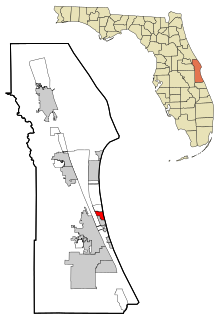
Satellite Beach is a coastal city in Brevard County, Florida. The population was 10,109 at the 2010 United States Census, and it is located with the Atlantic Ocean to the east and the Indian River to the west.
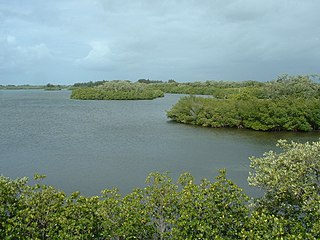
Windsor, formerly known as North Beach, is a gated community and census-designated place (CDP) on North Hutchinson Island in Indian River County, Florida, United States. The population was 256 at the 2010 census. It is part of the Sebastian–Vero Beach Metropolitan Statistical Area.

Vero Beach is a city in and the seat of Indian River County, Florida, United States. It is thirty-four miles south from Melbourne. According to the U.S. Census Bureau's 2010 data, the city had a population of 15,220.
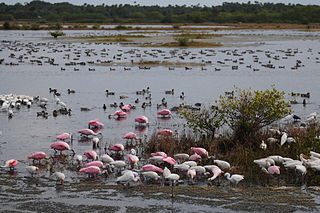
Merritt Island National Wildlife Refuge is a 140,000 acres (57,000 ha) U.S. National Wildlife Refuge (NWR) on the Atlantic coast of Florida's largest barrier island. NASA's Kennedy Space Center and visitor complex are also situated on the island and NASA can restrict access to the refuge based on its operational needs.

Sebastian Inlet, located in Sebastian Inlet State Park in Brevard County, Florida and Indian River County, Florida, offers surfing and fishing opportunities. It is off State Road A1A just 12 miles north of Vero Beach. There are annual surf tournaments, professional and amateur. Visitors fish there, particularly for Snook and Redfish.

The Treasure Coast is a region of the U.S. state of Florida. It is located on the state's Atlantic coast, comprising Indian River, St. Lucie, and Martin counties. The region, whose name refers to the Spanish Treasure Fleet lost in a 1715 hurricane, evidently emerged from residents' desire to distinguish themselves from Miami and the Gold Coast region to the south.

The Indian River Lagoon is a grouping of three lagoons: the Mosquito Lagoon, the Banana River, and the Indian River, on the Atlantic Coast of Florida; one of the most biodiverse estuaries in the Northern Hemisphere and is home to more than 4,300 species of plants and animals.
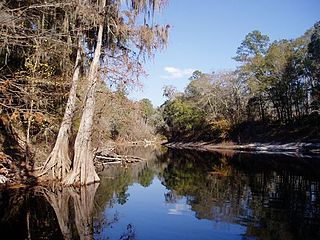
Suwannee River State Park is a Florida State Park located near Live Oak. It offers some of the best backcountry canoeing opportunities in the state. Visitors can see cypress trees, southern magnolia, herons, American coots, turtles and hawks. The park is open year-round.

Fort Pierce Inlet State Park, a 340-acre (1.4 km2) part of the Florida State Park system, is located just north of the Fort Pierce Inlet, on North Hutchinson Island, near Fort Pierce. It consists of beaches, dunes and a coastal hammock between the Atlantic Ocean and the waters of Tucker Cove, an indentation of the Indian River Lagoon.

San Pedro Underwater Archaeological Preserve State Park is a Florida State Park located in 18 feet (5.5 m) of water, approximately 1.25 nautical miles (2.32 km) south of Indian Key. It became the second Florida Underwater Archaeological Preserve when it opened to the public in 1989. The heart of the park is the San Pedro, a submerged shipwreck from a 1733 Spanish flotilla, around which visitors can dive and snorkel. The San Pedro, a 287-ton Dutch-built vessel, and 21 other Spanish ships under the command of Rodrigo de Torres left Havana, Cuba, on Friday, July 13, 1733, bound for Spain. The San Pedro carried a cargo of 16,000 silver Mexican pesos and crates of Chinese porcelain. A hurricane struck the fleet, while entering the Straits of Florida, and sank or swamped most of the fleet. The wrecksite includes an "eighteenth century anchor, replica cannons, ballast stones encrusted with coral, a dedication plaque, and a mooring buoy system." The wreck was added to the U.S. National Register of Historic Places on May 31, 2001.

Delaware Seashore State Park is located near Dewey Beach, in Delaware, United States. It is bounded on the east by the Atlantic Ocean and on the west by Rehoboth Bay and Indian River Bay. The park covers 2,825 acres (1,143 ha). It is a major attraction for millions of visitors who come to the Delaware Beaches for water-related activities. Delaware Seashore State Park was created in 1965.

Urca de Lima is a Spanish shipwreck near Fort Pierce, Florida, United States. She was part of the 1715 Treasure Fleet, herself, one of the numerous Spanish treasure fleets sailing between Spain and its colonies in the Americas. The wreck is located north of Fort Pierce Inlet, 200 yards off the shore from Jack Island Park. It became the first Florida Underwater Archaeological Preserve when dedicated in 1987. This was followed on May 31, 2001 with its addition to the U.S. National Register of Historic Places.

The 1715 Treasure Fleet was a Spanish treasure fleet returning from the New World to Spain. At two in the morning on Wednesday, July 31, 1715, seven days after departing from Havana, Cuba, under the command of Juan Esteban de Ubilla, eleven of the twelve ships of this fleet were lost in a hurricane near present-day Vero Beach, Florida. Because the fleet was carrying silver, it is also known as the 1715 Plate Fleet. Some artifacts and even coins still wash up on Florida beaches from time to time.According to Cuban records around 1,500 sailors perished while a small number survived on lifeboats. Many ships, including pirates, took part in the initial salvage. Initially a privateer, Henry Jennings, was first accused of piracy for attacking such salvage ships and claiming their salvages.

Environmental issues in Brevard County in Florida United States are highlighted by the amount of waterline, the amount of wetlands, the quantity of residents and visitors to the area, as well as the usual threat to air quality from commuters. Assisting in this is the Florida Space Coast Clean Cities Coalition which headquartered in Brevard. It encompasses a nine-county area.
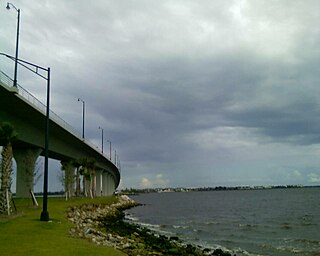
North Hutchinson Island is a coastal barrier island in Indian River and St. Lucie counties on the east coast of Florida in the United States. The island is adjacent to the Atlantic Ocean and is separated from the mainland on the west by the Indian River Lagoon. The portion of the island in Indian River County is known as Orchid Island.
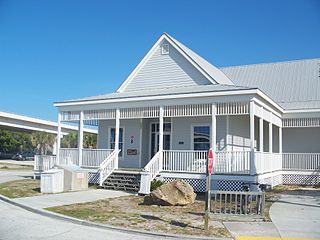
The Sebastian Fishing Museum is located in Sebastian Inlet State Park at the Sebastian Inlet State Recreation Area, 9700 South Highway A1A, Melbourne Beach, Florida, although it is physically located on Orchid Island, Indian River County side of the park. It houses historical exhibits of the local fishing industry and its influence on the area.

The McLarty Treasure Museum is located at 13180 North A1A on North Hutchinson Island, north of Windsor and Vero Beach, Florida, on the barrier island at the north end of Indian River County. The museum occupies part of the former site of the Survivors' and Salvagers' Camp - 1715 Fleet, and is part of Sebastian Inlet State Park. It houses exhibits on the history of the 1715 Spanish treasure fleet, and it features artifacts, displays, and an observation deck that overlooks the Atlantic Ocean. An A&E Network production, The Queen's Jewels and the 1715 Fleet, is shown, telling of the fleet's attempt to return to Spain when a hurricane struck off the Florida coast 300 years ago.

The Sebastian Inlet Bridge is a high concrete bridge. It spans the Indian River outlet which is also referred to as the Sebastian Inlet. It carries State Road A1A between Indian River County and Brevard County.





















